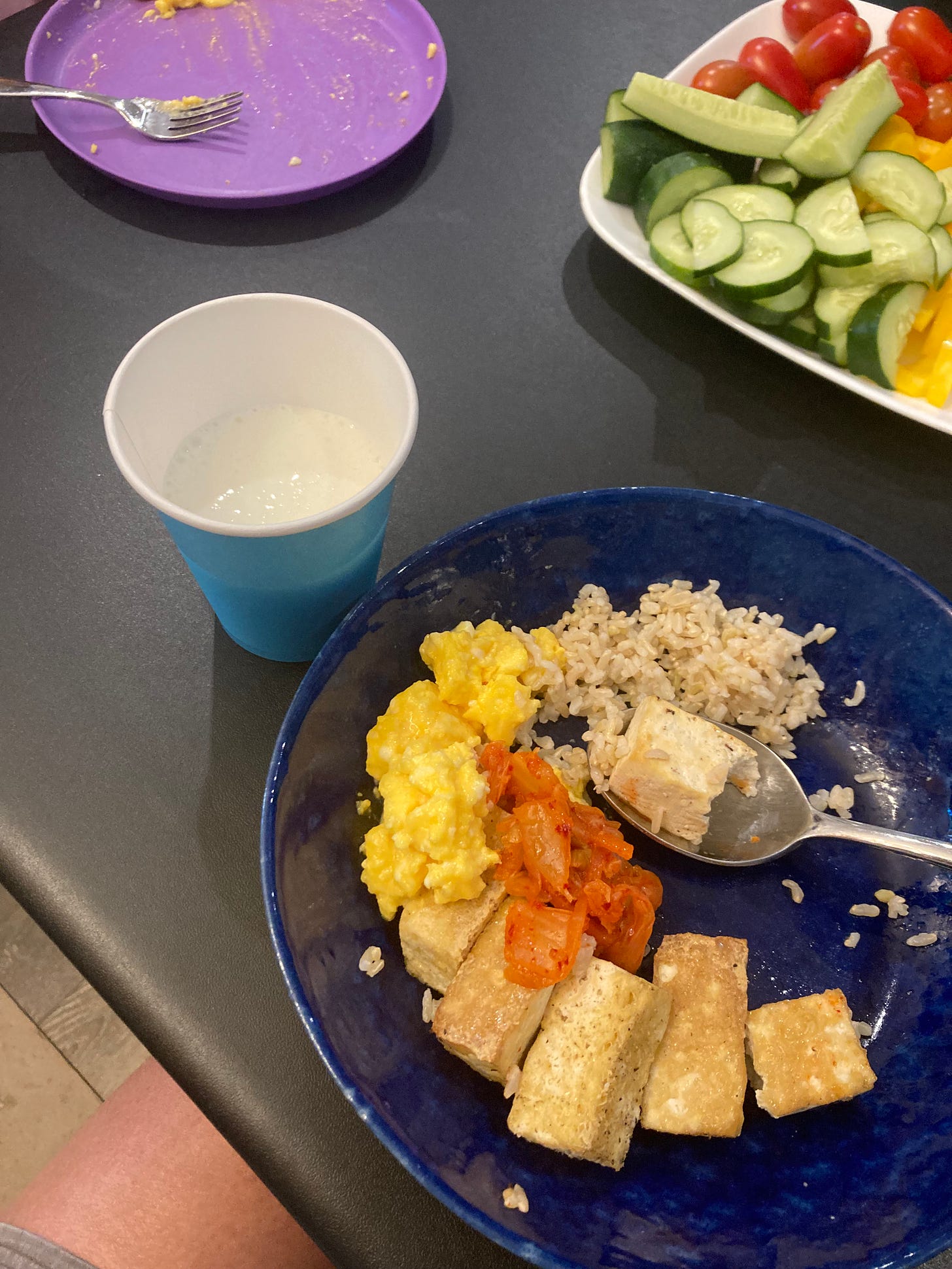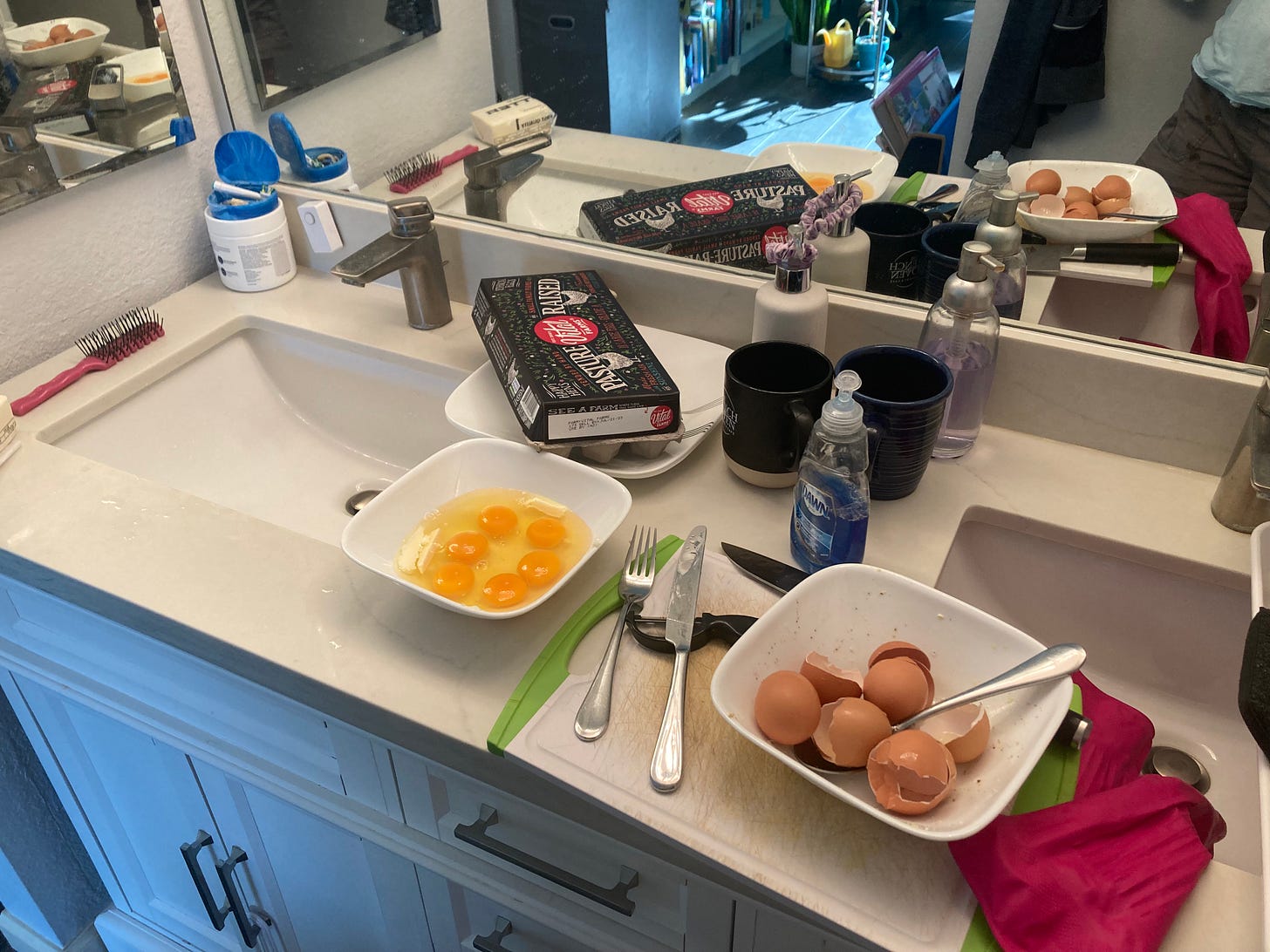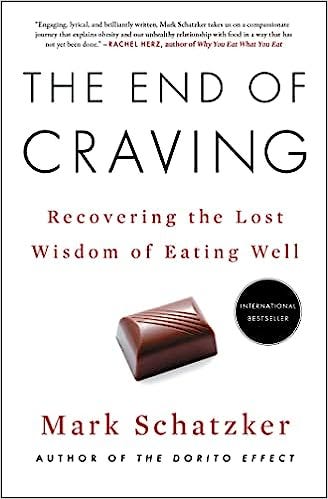Visits to the farmers’ market*
Our first trip to the local farmers’ market was on 25 March, and since that day we’ve been seven more times (notably for four weeks in a row in June and July). I thought that maybe tracking spending at the farmers’ market would be too hard to do and I’d give up on this whole food spending tracking enterprise and just buy food like a normal human. But that is not what happened! I couldn’t help myself. I carefully kept track of the cost of everything we bought, and which food stalls from which we bought lunch, and I would text my long-suffering and well-trained husband the amounts as soon as I could. Which means the data nerdery continues.
In our eight farmers’ market trips in 2023 so far, we spent $416 on produce, for an average of $52 per trip. This is usually on fruit, sometimes vegetables, and occasionally honey, nuts, or meat. We had stopped our CSA box subscription when we lost the kitchen, but the farm that we order the CSA through has a stand at this farmers’ market so I make a point of buying from them as much as I can to still support them — of the $416 we spent at the farmers’ market, $213 was at ‘our’ farm stall.
When we go to the farmers’ market, we usually have lunch there too. In these eight trips to the farmers’ market, we spent $504.13 total on the food stalls there, for an average of $63.02 per trip. The highest amount we spent was $90.51, and on that day we bought smoothies and a few different small things from a number of different stalls. The lowest amount was $52.01, and on that day we bought larger meals from three different stalls — this, I’ve discovered, is the trick to eating relatively cheaply at the farmers’ market. Find the places that sell complete meals and skip the smaller tapas-amounts of food, because it’s more economical that way.
Eating and drinking bacteria
I’m hesitant to call my recent consumption of fermented foods an obsession because I haven’t started making my own fermented foods or eating them on a daily basis (yet). But my latest food-related interest is in fermented foods, thanks to a few podcasts I’d listened to recently. I’ve known for awhile that fermented foods are good for your gut microbiome, but it took listening to a few podcasts to provide the proverbial kick up the bum and actually buy some kefir and kimchi.
Stay Feeling Good episode of Stay Young with Michael Mosley on the BBC
Eat Some Bacteria episode of Just One Thing with Michael Mosley on the BBC
Food special with Tim Spector episode of Just One Thing with Michael Mosley on the BBC (I mentioned this one in the last newsletter)
In these podcast episodes, the host, Dr Michael Mosley, and his guests talk about the importance of the gut microbiome for health, including how having diverse microbiota can reduce inflammation, strengthen the immune system, and improve mood and stress levels. There has been a lot of recent research that shows the effects of consuming fermented foods on the diversity of a person’s microbiota, and a lot of current research now exploring the effects of this on health more generally. In keeping with my rule-following tendencies, I’m therefore trying to introduce more fermented foods into my diet, and recently bought kefir, kimchi, and even kefir soda from the farmers’ market. (In the photo below, that’s kimchi with baked tofu, scrambled eggs, and rice, with a cup of kefir on the side.)
When the reno is done and we have a kitchen, I want to try making my own kefir, kimchi, and sauerkraut and incorporate fermented foods into our diets and meal plans even more. Oh such grand plans for when I can properly cook again! I bet my husband is thrilled (I haven’t told him yet).
How to cook scrambled eggs in the microwave
Speaking of cooking without a kitchen, I’ve made scrambled eggs in the microwave a few times now, and I’ve figured out how to do it well. This is how I do it:
Take six eggs and a bowl into the bathroom. Crack the eggs in the sink to minimise egg splatter and cleaning up of non-kitchen counter spaces. Try not to drop the egg down the sink (I did that the first time I tried this).
Whisk with a fork because our actual whisk is in storage. Make sure the yolks and whites are well combined. Add in a splash of milk (maybe a tablespoon’s worth?), and a wodge of butter (maybe half a tablespoon of butter?). Also add in some salt, about three or four twists of the salt grinder.
Whisk again and make sure everything is all mixed up.
Pop it in the microwave and let it go for 45 seconds (I think on high; I never adjust the power level on the microwave so I think the default is high).
Stir, and try not to make a mess and get raw egg everywhere. (I stick my arm and fork into the microwave and stir without taking the bowl out of the microwave because there’s no space.)
Another 30 seconds on high.
Repeat the stir and microwave-in-small-increments steps until mostly done. When stirring, keep scraping down from the sides because that cooks before the bits in the middle.
This is the most important step! Don’t wait until it looks completely cooked before you stop microwaving. Stop when it’s still a little liquid-y in the middle but done on the edges — the heat from the cooked bits will continue cooking the runny bits in a process called carryover cooking, especially as you give it one final stir. Trust the carryover cooking process.
One final sprinkle of salt and stir, and serve.
Annoyingly it will be very hard to get the egg completely off the bowl and washing it will be a little eggy and gross, so this is the point where I am grateful that we still managed to eat scrambled eggs and simultaneously resolve to never cook them in a microwave if I don’t have to again.
The only food book I’ve reread
When I was a kid, I reread books a lot. This is why I know so much Baby-Sitters Club trivia (I’m pretty sure that if I ever get old and lose my memory and stop recognising my husband and children, I will still be able to tell you all the chapter two biographical details of the BSC members). As an adult, I don’t reread as much, but recently I reread a food book — The End of Craving by Mark Schatzker. It is a funny and informative book and Schatzker brilliantly explains the science behind a lot of nutrition, including research about sweeteners and added vitamins in food, and why they might not be so good for us after all. This book was a quick and easy read that I really enjoyed.
*Apparently the correct way of writing ‘farmers’ market’ is without the apostrophe, according to many style guides (so ‘farmers market’ is correct), because the farmers don’t own the market. But I can’t help putting an apostrophe in because I feel like, on a philosophical level, they do. There might be some other organising body in charge of the logistics, but without the farmers, you don’t have a farmers’ market. Also without the apostrophe it makes it seem like I’m going to a market to buy farmers. I’ve just resigned myself to being wrong on this point, style guides be damned.






